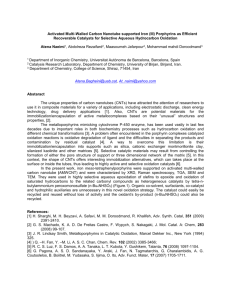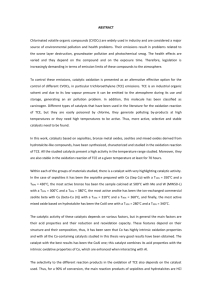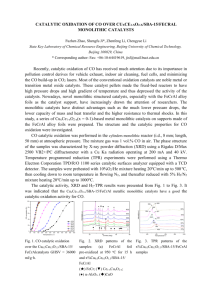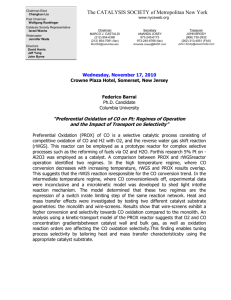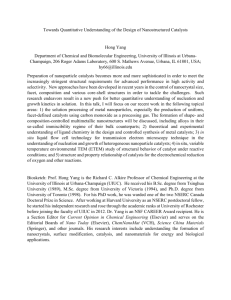Selective Liquid Phase Oxidation of Alkene with Dioxygen on
advertisement
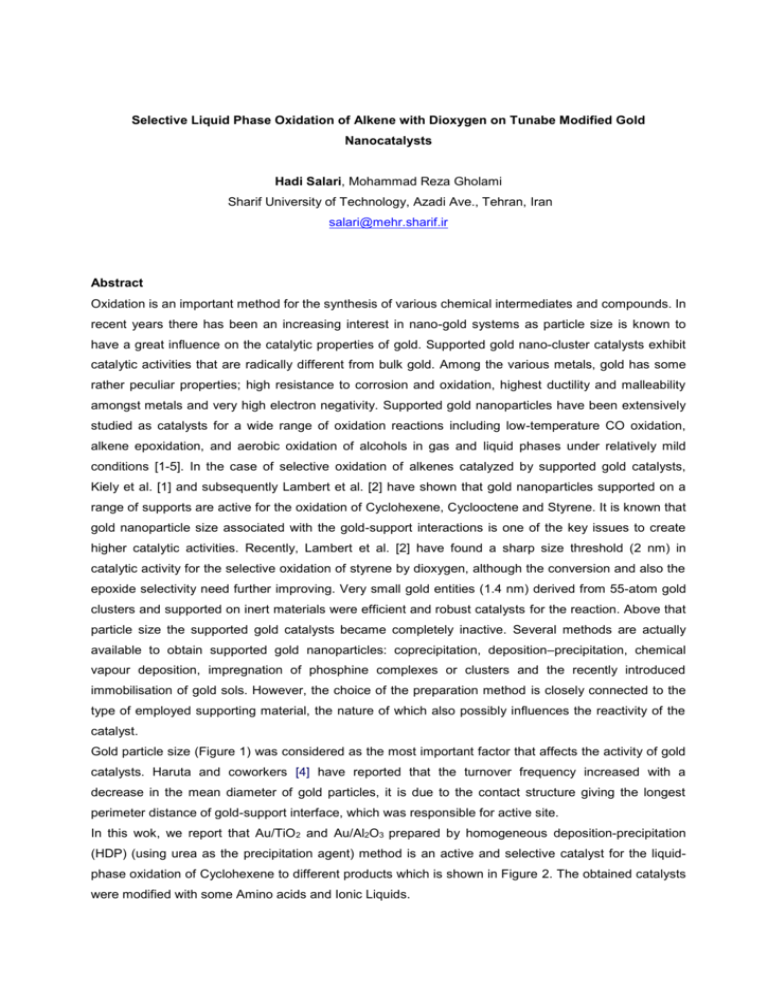
Selective Liquid Phase Oxidation of Alkene with Dioxygen on Tunabe Modified Gold Nanocatalysts Hadi Salari, Mohammad Reza Gholami Sharif University of Technology, Azadi Ave., Tehran, Iran salari@mehr.sharif.ir Abstract Oxidation is an important method for the synthesis of various chemical intermediates and compounds. In recent years there has been an increasing interest in nano-gold systems as particle size is known to have a great influence on the catalytic properties of gold. Supported gold nano-cluster catalysts exhibit catalytic activities that are radically different from bulk gold. Among the various metals, gold has some rather peculiar properties; high resistance to corrosion and oxidation, highest ductility and malleability amongst metals and very high electron negativity. Supported gold nanoparticles have been extensively studied as catalysts for a wide range of oxidation reactions including low-temperature CO oxidation, alkene epoxidation, and aerobic oxidation of alcohols in gas and liquid phases under relatively mild conditions [1-5]. In the case of selective oxidation of alkenes catalyzed by supported gold catalysts, Kiely et al. [1] and subsequently Lambert et al. [2] have shown that gold nanoparticles supported on a range of supports are active for the oxidation of Cyclohexene, Cyclooctene and Styrene. It is known that gold nanoparticle size associated with the gold-support interactions is one of the key issues to create higher catalytic activities. Recently, Lambert et al. [2] have found a sharp size threshold (2 nm) in catalytic activity for the selective oxidation of styrene by dioxygen, although the conversion and also the epoxide selectivity need further improving. Very small gold entities (1.4 nm) derived from 55-atom gold clusters and supported on inert materials were efficient and robust catalysts for the reaction. Above that particle size the supported gold catalysts became completely inactive. Several methods are actually available to obtain supported gold nanoparticles: coprecipitation, deposition–precipitation, chemical vapour deposition, impregnation of phosphine complexes or clusters and the recently introduced immobilisation of gold sols. However, the choice of the preparation method is closely connected to the type of employed supporting material, the nature of which also possibly influences the reactivity of the catalyst. Gold particle size (Figure 1) was considered as the most important factor that affects the activity of gold catalysts. Haruta and coworkers [4] have reported that the turnover frequency increased with a decrease in the mean diameter of gold particles, it is due to the contact structure giving the longest perimeter distance of gold-support interface, which was responsible for active site. In this wok, we report that Au/TiO2 and Au/Al2O3 prepared by homogeneous deposition-precipitation (HDP) (using urea as the precipitation agent) method is an active and selective catalyst for the liquidphase oxidation of Cyclohexene to different products which is shown in Figure 2. The obtained catalysts were modified with some Amino acids and Ionic Liquids. The Cyclohexene oxidation reaction over the catalysts was carried out at 2 atm pressure of Oxygen gas by contacting 0.03 gr catalyst with 0.7 ml Cyclohexene in 15 ml solvent in a stirred batch reactor (capacity: 50 cm 3), under reflux (at 80–82 0C) and vigorously stirring for a period of 24 h. The catalyst was separated from the reaction mixture by filtration. The reaction products and unconverted reactants were analysed by GC with FID using HP5 column and He as carrier gas. The reaction performed in Hexane, 1,4-Dimethylbenzene, 1,2-Dimethylbenzene, Tolouene, Chlorobenzene and some Ionic Liquids as new classes of friendly environmentally solvents. The results showed that selectivity and productivity of reaction are influenced drastically by solvents systems. Gold catalysts have significant potential for selective oxidation of alkenes. The productivity of reaction increases with Au loading percent increasing. High selectivity of Cyclohexene demonstrates that oxidation of C=C double band is occurring with these catalysts. References [1] Mathew D. et al., Nature, 437 (2005) 1132-1135. [2] Mark Turner, et al., Nature, 454 (2008) 981-983. [3] T.V. Choudhary and D.W. Goodman, Topics in Catalysis, 21 (2002) 25-34 [4] M. Date, et al., Catal Today, 72 (2002) 89–94. [5] An-Fei An, An-Hui Lu, Qiang Sun, Jie Wang, Wen-Cui Li, Gold Bull, 44 (2011) 217–222 Figures Figure 1. TEM images of supported Au catalysts. Figure 2. Cyclohexene oxidation reaction with molecular oxygen using Au catalysts.

